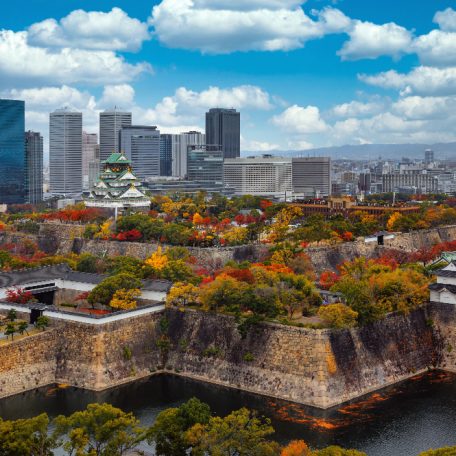THINGS TO DO IN KYOTO IN OCTOBER 2024
Oct 1, 2024
BY Shalini Sookoo

Picture this: the weather starts getting cooler giving a most gracious reprieve from the summer sun and the days get longer to allow you to enjoy more of the city. Yes, folks. Autumn is on the way. Whilst you may not see much of a change in the leaves in October there are still lots to do in Kyoto. Let’s take a look, shall we?

A group carrying the Zuiki Festival Mikoshi – Photo Credit: Discover Kyoto
Zuiki Matsuri
First on our list is Zuiki Matsuri (ずいき祭). This five-day-long festival has roots dating back to the 1900’s and is held to celebrate the Autumn harvest. On the first day, the procession departs from the Kitano Tenmangū shrine with numerous omikoshi (portable shrines) to a temporary shrine, Otabisho, after making the rounds around the neighborhood. These omikoshi are usually decorated with dried goods and other vegetables such as taro stems (zuiki) on the roof and tofu skins, dried greens, marigolds, and even wheat! On each side, legendary artwork and creatures are depicted also using vegetables. Rituals are conducted at Otabisho including a dance performed by young girls called Yaotome Dance. After three days, the omikoshi is returned to Kitano Tenmangū via ox-drawn carts. On the final day, ceremonies are performed to conclude the festival including one last dance offering. You can usually find the geiko and maiko of Kamishchiken district viewing the processions on the streets as well.
Dates: October 1st – 5th, 2024
Location: Kitano Tenmangū Shrine to Otabisho
Start/End Time: 10 A.M. – TBA
Fees: Free
Website: https://www.kamigamojinja.jp/en/

Huge Paper Kitsune Lantern at Awata Shrine – Photo Credit: Stray Toki
Awai Taisai
In mid-October, Awata Shrine found in northern Higashiyama near the Chion-in and Shōren-in temples hosts a series of colorful annual rituals and parades. There are two highlights to this festival – the Reiken Ceremony and the Shinkō-sai Procession. The Reiken Ceremony involves large, traditional Japanese paper lanterns in the form of mythological creatures and deities. These lanterns are also paraded through the Higashiyama area though they really come alive at night when lit! Some types of lanterns you may see include the Lucky God Ebisu, the Ox-Headed Heavenly King and even zodiac animals. During this ceremony, the procession carries the lanterns as well as shrine treasures and torches to Chion-in.
The Shinkō-sai Procession on the other hand involves transporting the shrine’s god via an omikoshi around the neighborhood. In addition, the omikoshi, eighteen, distinct sacred polearms (kenboko) rumored to dispel evil spirits are also carried by talented bearers to make the bells ring. Some Kenboko, relics and altars are even displayed around the neighborhood so there is much to see and experience!
Date: October 12th – 15th, 2024
Location: Awata Shrine
Fees: Free

Men dressed in traditional gear firing off muskets – Photo Credit: Funaoka Taisai Official Website
Funaoka Taisai
Funaoka Grand Festival or Funaoka Taisai is annually held on Mt Funaoka at Kenkun Shrine to pay tribute to the accomplishments of Oda Nobunaga, a feudal lord from the 16th century. This marks the anniversary of Oda Nobunaga’s march into the former capital in 1568 where he began to drive out the Miyoshi clan. But why the celebration? And why at Kenkun Shrine on Mt Funaoka? Well, in Japanese history, Oda Nobunaga was one of three people who participated in unifying Japan and ending the period of unrest the country was subjected to since the later half of the Muromachi Period. As for the second question, Kenkun Shrine is where the deity of Oda Nobunaga is enshrined. The festival involves re-telling the feudal lord’s history to youth as well as making offerings to the enshrined warrior. Priests also conduct prayers and guide visitors in showing reverence. A highlight of the festival is the Atsomori or plain clothes nō dance (rumored to be the feudal lord’s favorite performance) as well as a bugaku performance.
Date: October 19th, 2024
Location: Kenkun Shrine, Mt. Funaoka.
Website: https://kenkun-jinja.org/en/rituals/

A Horseback Archer preparing to fire – Photo Credit: Josiah S
Kasagake Shinji
During October every year, an equestrian archery event is held at Kamigamo Shrine. To entertain shrine deities, there are three styles of archery usually performed, one of which is Kasagake Archery. In Japanese history, instead of being a religious offering, this event was used as practice drills. Today, it is used as a religious offering and performed by the trained members of the Takeda-ryū school of horseback archers. In this style of archery, there are five targets split into two different levels in order to recreate a battlefield and its scenarios. After each run, hits and scores are announced. As the highest scoring riders advance into the following rounds, the targets become smaller in size. This is an exhilarating festival to witness, drawing you back into Japanese history!
Date: October 20th, 2024
Location: Kamigamo Shrine
Time: 12:30 PM

Saigu Procession – Photo Credits: David Carillet
Saigū Gyōretsu
In mid-autumn, surrounded by Arashiyama’s bamboo forest, Nonomiya shrine hosts the Saigū Gyōretsu – a reenactment of the priestess’ departure for Ise. In the past, women from the imperial family known as Saigū underwent purification rituals before being appointed as emissary priestesses to the grand shrine in Ise where Amatersau, the sun goddess, was worshiped. During this procession, people are customarily dressed in court regalia as they travel to the river for the purification rituals. The highlight of the procession, however, is the Saigū-dressed women either riding on an ox cart or in a palanquin. Once at the purification site, the shrine’s priestesses first perform a dance followed by prayers recited by a priest. The Saigū would then release a paper doll in an Omisogi no Gi ceremony at the water’s edge. Observants are also allowed to take part in prayers towards the Ise Shrine whilst gagaku (traditional court music) and bugaku (dance) are performed as offerings.
Date: October 20th, 2024
Location: Nonomiya Shrine, Arashiyama
Fees: Free

Jidai Matsuri – Photo Credits: Jasonyan
Jidai Matsuri
Jidai matsuri involves a 5-hour historical reenactment parade from the Imperial Palace to Heian Shrine involving different eras in Kyoto’s history. To commemorate the former capital’s (Kyoto’s) history, the first Heian Shrine was built in 1895 for the first Jidai festival’s inauguration and to enshrine Emperor Kanmu’s spirit who initiated the commemoration of the city in 794. Did you know that Kyoto was once called Heian-kyō (平安京)?
In the early morning of Jidai Matsuri you can see mikoshi (portable shrines) being brought out of the Imperial Palace for people to pay their respects. These shrines are representatives of not only Emperor Kanmu but also Emperor Kōmei who is renowned for unifying Japan, the imperial court’s power and Kyoto as Japan’s center at the end of the Edo period. If you want to follow along you better be prepared with comfy shoes and water since the parade usually begins in the afternoon.
Date: October 22nd, 2024
Location: Imperial Palace to Heian Shrine via Oike and Sanjo Streets
Start Time: 12 PM
Fees: Free along the parade route. Reserved seating at Kyoto Imperial Palace, in front of Kyoto City Hall and nearing Heian Shrine at a cost of 4000 – 6000 yen.
Website: https://kyoto.travel/en/season_festivals/jidai_matsuri.html
Although Kyoto may no longer be the capital of the country, it does represent years that have since passed, leaving behind a robust history for the city’s culture to develop from. Being a modern city in a modern world, you can’t ignore the realities of changing times. But through combining elements of both the past and present, Kyoto becomes a beautiful symbol of perseverance through its mixture of old-fashioned traditions and modern-day innovations. We must keep the vision of these times alive so we can live the best of both worlds! The weather is changing, and new things are happening everywhere you look, Kyoto is calling you: Come and see it for yourself!

Yuki-jinja Shrine, Kurama, Kyoto – Photo Credits: mTaira
Kurama Fire Festival
The Kurama fire festival is another festival also on October 22 based on Mt. Kurama outside of downtown Kyoto at Yuki-jinja Shrine. This festival begins at dusk with a parade when each house lights a small torch. It is a tradition for homes to display their family heirlooms in their windows so you may even catch a glimpse of a samurai’s armor! This is also considered as a rite of passage for youth hence children can first be seen leading the parade with small torches followed by teenagers. Bringing up the rear of the parade are the village’s men carrying rather large torches. Some villagers also carry mikoshi. At the end of the parade, the torches are used to create a huge bonfire. To secure a viewing spot, we recommend you make sure and get there early.
Date: October 22nd, 2024
Location: Yuki-jinja Shrine

Nuit Blanche logo for 2024 – Photo Credit: https://nuitblanche.jp/
Nuit Blanche Kyoto
This contemporary art festival was inspired by Paris’ Nuit Blanche festival and involves collaborations between artists, the curator,s and craftsmen at multiple locations in Kyoto. Whilst the opening ceremony takes place with several performances on September 28th, many exhibitions are open until October 28th with some running into November. If you’re an art lover, be sure to check out some of the exhibitions!
Date: Begins on September 28th and runs throughout October
Location: Various
Website: https://nuitblanche.jp/

Geisha Performance – Photo Credits: wang xi
Experience Autumn Geisha Dances
In October, theaters in the four of the five geisha quarters, or hanamachi, host a variety of dance performances by geckos and maikos, the apprentice geisha. First is the Onshukai dances by the geisha of Gion-Kobu in the Gion district followed by the Mizuekai dances by the Miyagawacho geisha in the second week and the Kotobukikai dances by the Kamishichiken geisha in the third week. Finally at the end of October, the Pontocho geisha perform the Suimekai dances.
Date: Early October to mid-October.
Fees: Between 4222 yen to 8444 yen

Official Event Poster – Photo Credit: Kyoto Antique Fair
Kyoto Antique Fair
Kyoto is the prime city for a taste of Japanese culture but if you don’t want to go around each and every shop, check out the Kyoto Antique Fair at the Kyoto Pulse Plaza convention center. The fair is held three times a year in March, June, and October with over 350 antiquities dealers. Stalls may specialize in certain items or may have a multitude. Either way, it’s a great place to enjoy a piece of Japanese culture. Besides the museums of course. Be sure to check it out!
Date: October 25th – 27th
Location: Kyoto Pulse Plaza
Fees: Free
Time: 10am to 5pm
Website: http://www.gomoku-do.com/index_en.html
As we move along in the year, Kyoto does not fail to offer a deep immersion into Japan’s rich cultural heritage. From witnessing historical parades to learning more about traditions and remembering the people who have paved the way for Japan to become the country it is today. This ancient city’s timeless treasures also extend to the elegant performances in the Gion district by the resident geisha and maiko. Indeed Kyoto is the city that bridges the gap between history and modern times, the city that ensures residents and visitors remember the cultural roots. And what better time to enjoy this time than in October’s cool, crisp air?
Feature photo credit: Gene Hiew
If you’re coming to Kyoto to check any of these events out, why not join a culinary tour and discover the city as a local?
PIN THIS FOR LATER
Book your pocket wifi now to stay connected through your entire Japan Journey!

Be sure to get the JR Pass to make navigating Japan during your trip that much easier!

YOU MIGHT ALSO LIKE





